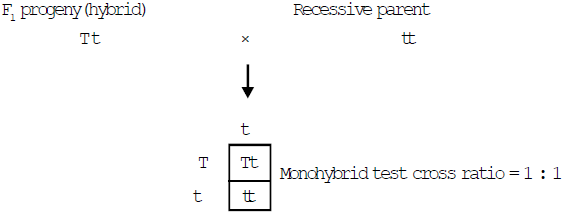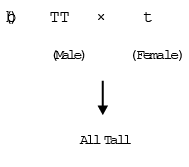In this article we will discuss about:- 1) Back cross 2) Out Cross 3) Test Cross 4) Reciprocal cross
1) Back Cross: A back cross is a cross in which F1 individuals are crossed with any of their parents.
2) Out Cross : When F1 individual is crossed with dominant parent then it is termed out cross. The generations obtained from this cross, all possess dominant character. so the any analysis can not possible in F1 generation.
3) Test Cross : When F1 progeny is crossed with recessive parent then it is called test cross. The total generations obtained from this cross, 50% having dominant character and 50% having recessive character. [Monohybrid test cross]. Test cross helps to find out the genotype of dominant individual.
[a] Monohybrid Test Cross :- The progeny obtained from the monohybrid test cross are in equal proportion , means 50% is dominant phenotypes and 50% is recessive phenotypes.
It can be represented in symbolic forms as follows.
[b] Dihybrid Test Cross:- The progeny is obtained from dihybrid test cross are four types and each of them is 25%.
The ratio of Dihybrid test cross = 1:1:1:1
Conclusion:- In test cross phenotypes and genotypes ratio are same.
4. Reciprocal cross
When two parents are used in two experiments in such a way that in one experiment "A" is used as the female parent and "B" is used as the male parent, in the other experiment "A" will be used as the male parent and "B" as the female parent. such type of a set of two experiments is called Reciprocal cross.
Characters which are controlled by karyogene are not affected by Reciprocal cross. In case of cytoplasmic inheritance result change by Reciprocal cross.
Genetics: Back Cross, Test Cross, Out Cross and Reciprocal cross
![Genetics: Back Cross, Test Cross, Out Cross and Reciprocal cross]() Reviewed by Rajkumar
on
February 16, 2019
Rating:
Reviewed by Rajkumar
on
February 16, 2019
Rating:





No comments: